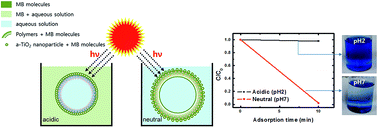A facile template-free synthesis of pH-responsive polyelectrolyte/amorphous TiO2 composite hollow microcapsules for photocatalysis†
Abstract
This paper presents a novel, facile method for fabricating pH-responsive inorganic/organic composite microspheres with hollow structures in the absence of a step for the removal of the core. Using polyelectrolyte (hydrogel) hollow microspheres without a need for further calcination and chemical etching, minimally cross-linked poly(methacrylic acid/ethylene glycol dimethacrylate/3-(trimethoxysilyl) propylmethacrylate), poly(MAA/EGDMA/TMSPM) [pMET] microspheres were prepared by a distillation–precipitation method. Once the pMET microspheres disperse in 2-propanol, the hollow structure is clearly observed and can be maintained more rigidly in a dry state after amorphous TiO2 (a-TiO2) is incorporated into the shell of a microsphere by a sol–gel method. The a-TiO2-incorporated pH-responsive pMET composite [pMET/TiO2] hollow microspheres were tested as a photocatalyst in acidic and neutral conditions. The photocatalytic performance of the hollow pMET/TiO2 composite microcapsules under neutral condition was better than that under acidic conditions due to their large active surface and strong adsorption ability against methylene blue (MB).


 Please wait while we load your content...
Please wait while we load your content...